A Creepy Catalogue: Common Parasites and How to Avoid Them
June 11, 2013
Let me be the first to admit that I do not do well with parasites. I’m most definitely not one of those dog people that can spot a case of mange from a mile away and deftly remove a tick with one arm tied behind my back. You’d probably find me gagging in a corner sooner than you’d find me springing into action. However, I do realize how important it is to be aware of this stuff. Some parasites can be, at their worst, life threatening and at the least, uncomfortable. We owe it to our dogs to recognize the symptoms (or lack thereof in some cases) and intervene early.
Heartworm.
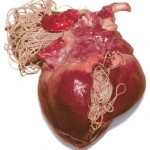
Don’t mess around with these guys. They can kill your dogs and you wouldn’t even know they were sick. These little gems are transmitted by mosquitos. Little microscopic versions are catapulted into your dog’s bloodstream and travel straight to the heart where they can grow up 6 or 8 inches (yes you heard it) long. All those lovely worms make it very difficult for your dog’s heart to do it’s job and the blood flow becomes restricted, leading to heart failure.
The real bummer? Once your dog has heartworm there’s not a whole lot you can do. Treatment is difficult and often unsuccessful. In this case, an ounce of prevention is definitely the motto. Go to your Vet and put your dog on a preventative medication as soon as possible. It’s not worth the risk.
Hookworm.
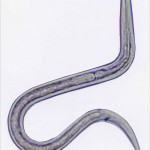 This little guys are the ones that make my skin crawl. You know why? We can get them too. That’s right folks. If your dog has picked up hookworm (by ingesting animal poop), you can share in the parasitic love together. They can make your dog very ill, causing weight loss, diarrhea, vomiting, anemia, and pneumonia.
This little guys are the ones that make my skin crawl. You know why? We can get them too. That’s right folks. If your dog has picked up hookworm (by ingesting animal poop), you can share in the parasitic love together. They can make your dog very ill, causing weight loss, diarrhea, vomiting, anemia, and pneumonia.
If you suspect hookworm, talk to your vet about a de-worming cycle and be very aware of keeping your backyard free of poop.
Roundworm.
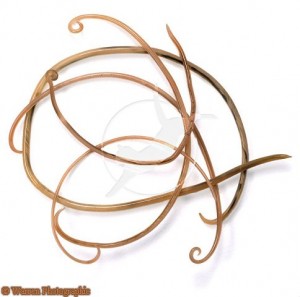 For some reason these guys don’t scare me as much. I think it might be because they’re just so darn common. It doesn’t make them any less disgusting or harmful, but the devil you know is better than the one you don’t right? These parasites are often transferred from the mother through her milk, or again, by ingesting infected poop (you’d think they’d learn?). They look like small spaghetti and in more serious cases, you can actually see them hanging out of a dog’s bum or in their vomit or poop. Not pretty. Those puppy bellies that are especially big and round are often infected with roundworm. They can cause vomiting, diarrhea, weight loss and lack of growth, so make sure you watch for signs early on.
For some reason these guys don’t scare me as much. I think it might be because they’re just so darn common. It doesn’t make them any less disgusting or harmful, but the devil you know is better than the one you don’t right? These parasites are often transferred from the mother through her milk, or again, by ingesting infected poop (you’d think they’d learn?). They look like small spaghetti and in more serious cases, you can actually see them hanging out of a dog’s bum or in their vomit or poop. Not pretty. Those puppy bellies that are especially big and round are often infected with roundworm. They can cause vomiting, diarrhea, weight loss and lack of growth, so make sure you watch for signs early on.
Tapeworm.
 You can all breathe a sigh of relief. We can only catch these guys from actually swallowing an infected flea. Our dogs catch them from eating wild animals like rats and mice that have fleas. They look like grains of rice. I’m sorry for the visual, but it’s true. They hang around your dog’s anus so its worthwhile getting familiar with the area just to be sure all is well. The clinical signs aren’t as obvious, but some dogs do suffer from weight loss and diarrhea, so a regular stool sampling (every 6 months) is probably the best way to be sure.
You can all breathe a sigh of relief. We can only catch these guys from actually swallowing an infected flea. Our dogs catch them from eating wild animals like rats and mice that have fleas. They look like grains of rice. I’m sorry for the visual, but it’s true. They hang around your dog’s anus so its worthwhile getting familiar with the area just to be sure all is well. The clinical signs aren’t as obvious, but some dogs do suffer from weight loss and diarrhea, so a regular stool sampling (every 6 months) is probably the best way to be sure.
Whipworm.
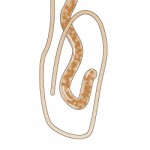 These guys are mostly limited to dogs and coyotes. They literally look like a “whip”, with a thicker back end and a long, skinny end. They can grow up to a full 3 inches in length and then they (wait for it), burrow their “whip” into the intestinal lining or the large intestine. If you were eating, I apologize. Can you guess how they’re transmitted? Big surprise…Poop eating! We don’t actually know if these can be transmitted to humans, so as usual, wash your hands often around dogs and pick up poop!
These guys are mostly limited to dogs and coyotes. They literally look like a “whip”, with a thicker back end and a long, skinny end. They can grow up to a full 3 inches in length and then they (wait for it), burrow their “whip” into the intestinal lining or the large intestine. If you were eating, I apologize. Can you guess how they’re transmitted? Big surprise…Poop eating! We don’t actually know if these can be transmitted to humans, so as usual, wash your hands often around dogs and pick up poop!
Fleas.
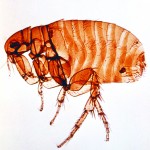 Nothing short of a major pain in the a@$. I don’t know a single person that doesn’t dread the moment they find that jumping little monster on their couch or carpet. Here’s a little trick for you courtesy of Linda Kytson of Canine Compass. Look for “flea dirt” (aka poop). It looks like specks of dirt. If you’re not sure if it’s dirt or flea poop, pour some water on it! If it turns reddish brown, then you’d better get ready to declare war on fleas in your house. We all know they thrive in warm weather, but it’s actually a myth that pets don’t need flea prevention in the winter as well. If your house is heated, then they can thrive. Just when you thought you could get a break.
Nothing short of a major pain in the a@$. I don’t know a single person that doesn’t dread the moment they find that jumping little monster on their couch or carpet. Here’s a little trick for you courtesy of Linda Kytson of Canine Compass. Look for “flea dirt” (aka poop). It looks like specks of dirt. If you’re not sure if it’s dirt or flea poop, pour some water on it! If it turns reddish brown, then you’d better get ready to declare war on fleas in your house. We all know they thrive in warm weather, but it’s actually a myth that pets don’t need flea prevention in the winter as well. If your house is heated, then they can thrive. Just when you thought you could get a break.
Ticks.
 Ok, I reserve a special sort of contempt for ticks. I can’t even think about them without recoiling. It’s a large parasite that survives by attaching itself to your dog and sucking it’s blood. Tiny, beige little Draculas. Ticks are becoming more common in Toronto and in general. They can cause Lyme disease, which is responsible for fever, lethargy, kidney failure, heart problems, meningitis, skin rashes, and sore muscles/joints.
Ok, I reserve a special sort of contempt for ticks. I can’t even think about them without recoiling. It’s a large parasite that survives by attaching itself to your dog and sucking it’s blood. Tiny, beige little Draculas. Ticks are becoming more common in Toronto and in general. They can cause Lyme disease, which is responsible for fever, lethargy, kidney failure, heart problems, meningitis, skin rashes, and sore muscles/joints.
If you find one on your dog be very careful. You’ll be so grossed out that you’ll have to suppress the urge to immediately crush it to death. The problem is that you have to remove it in a very specific way. You can’t just rip it off or the thing’s head will remain stuck in your poor dog’s skin, which can cause some pretty gnarly infections. Put some gloves on and spray a little bug spray on the tick first, or cover it with Vaseline. If it doesn’t fall off on its own, grab some tweezers and pull it out as close to the dog’s skin as possible. Do NOT twist, as you might twist the head and mouth off. You need to get the WHOLE thing, so just pull straight back with steady pressure. Then you need to put the little sucker in a bag and have your vet examine it. Gross, but necessary.
Ear Mites.
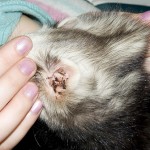 Is your dog shaking his head a lot? Is he incessantly scratching at his ears? He might be blessed with the joys of ear mites. These are literally tiny little bugs that hang out in your dog’s ears and cause a whole lot of irritation. They look like coffee grinds or dirt and they smell worse than a hockey bag. They cause the ear, in defending itself, to secret a thick, waxy discharge that clogs the ear. Because of all the constant scratching a lot of dogs develop ear infections-not a good situation.
Is your dog shaking his head a lot? Is he incessantly scratching at his ears? He might be blessed with the joys of ear mites. These are literally tiny little bugs that hang out in your dog’s ears and cause a whole lot of irritation. They look like coffee grinds or dirt and they smell worse than a hockey bag. They cause the ear, in defending itself, to secret a thick, waxy discharge that clogs the ear. Because of all the constant scratching a lot of dogs develop ear infections-not a good situation.
Mange.
 The type of Mange that we typically have to worry about is caused by tiny little mites burrowing under the dog’s skin and causing a whole lot of itchiness. The hair also falls out and the skin can become scaly and crusty. Did I mention crusty? We were introduced to this lovely condition when we were living in Taiwan. Our male Maltese Quincy decided to have a good ol’ fashioned roll in the grass at the local feral dog park hang-out. It’s not fun to get rid of, so if you notice it, get to the Vet pronto.
The type of Mange that we typically have to worry about is caused by tiny little mites burrowing under the dog’s skin and causing a whole lot of itchiness. The hair also falls out and the skin can become scaly and crusty. Did I mention crusty? We were introduced to this lovely condition when we were living in Taiwan. Our male Maltese Quincy decided to have a good ol’ fashioned roll in the grass at the local feral dog park hang-out. It’s not fun to get rid of, so if you notice it, get to the Vet pronto.
Ringworm.
 Talk about misleading names. Ringworm is not a worm. It’s a fungus. Your dog needs to come into contact with Ringworm on another animal or something in it’s environment to catch it. Because it’s HIGHLY contagious, it tends to hang out where large groups of animals are and then refuses to leave. Watch for patchy hair loss and lesions around the head, feet, ears, and eyes. It’s uber itchy, so if your dog is looking a little scaly and scratching himself a lot be aware. The worst part is that it’s easily transmitted to humans. Oh ya, and it’s hard to get rid of. If you do notice it, prepare to go to war. Cleaning, vacuuming and cleansing ever corner of your house, while also getting Vet treatment.
Talk about misleading names. Ringworm is not a worm. It’s a fungus. Your dog needs to come into contact with Ringworm on another animal or something in it’s environment to catch it. Because it’s HIGHLY contagious, it tends to hang out where large groups of animals are and then refuses to leave. Watch for patchy hair loss and lesions around the head, feet, ears, and eyes. It’s uber itchy, so if your dog is looking a little scaly and scratching himself a lot be aware. The worst part is that it’s easily transmitted to humans. Oh ya, and it’s hard to get rid of. If you do notice it, prepare to go to war. Cleaning, vacuuming and cleansing ever corner of your house, while also getting Vet treatment.
Well, I hope I didn’t spoil your meal. The most important lesson here is that prevention is key. Take your dog for regular stool samples and give him weekly examinations if you can, by looking him over thoroughly. If you notice anything unusual, smelly or scary at least you’ll have caught it early.
Source: Pet First Aid Manual, Walks ‘n’ Wags Pet First Aid